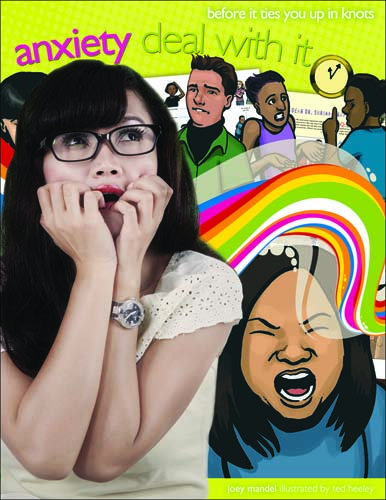| ________________
CM . . .
. Volume XXI Number 27. . . .March 20, 2015
excerpt:
Part of the “Deal with It” series, Anxiety: Deal with It Before It Ties You Up in Knots discusses the most common mental health issue facing Canadian children and youth today. According to the author, anxiety is fear-based and can interfere with daily living and enjoyment of life. The aim of this book is to help kids learn to face their fears and gain control over their anxiety. To begin, the book explains the basic differences between anxiety and the survival instinct and demonstrates how anxiety can affect many areas of one’s life. Various forms of anxiety are mentioned, including Obsessive Compulsive Disorder, panic attacks and excessive collecting which stems from a person’s need to have some measure of control over his or her world. As well, there are three standard reactions to the anxiety issues of others: avoidance, attack and assistance. The first two reactions tend to raise anxiety levels in the observer, but if he or she takes the time to understand the problem or situation and offers suggestions or assistance, this diffuses the anxiety in the one experiencing it and also calms the person who is offering the advice. Throughout the book, there are quizzes and scenarios which help to dispel myths surrounding anxiety and offer examples of how to keep the mind and body calm during times of stress. As well, “Did You Know?” bands across the bottom of some pages provide facts and statistics, one example being that anxiety and depression occur together 50-60% of the time. Of all the titles in the series, this one seems to be geared toward a bit younger audience, perhaps because “70% of cases of anxiety and other mental health issues begin during childhood”, and it has been proven that early intervention can decrease anxiety. The tips for what to do when one is having a meltdown, however, require a “cool” head and a level of maturity unless these tips are introduced and discussed with a trusted adult, be it a parent, teacher or guidance counselor. Cartoon-like illustrations are in keeping with the rest of the series. A list of mental health web sites and books related to the topic can be found at the back of the book. Recommended. Gail Hamilton is a former teacher-librarian in Winnipeg, MB.
To comment
on this title or this review, send mail to cm@umanitoba.ca.
Copyright © the Manitoba Library Association. Reproduction for personal
use is permitted only if this copyright notice is maintained. Any
other reproduction is prohibited without permission.
Next Review |
Table of Contents for This Issue
- March 20, 2015. |
